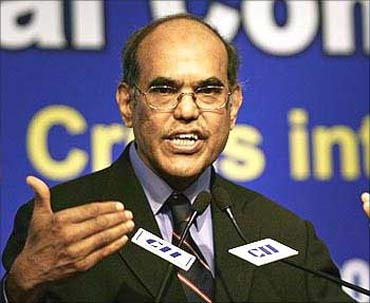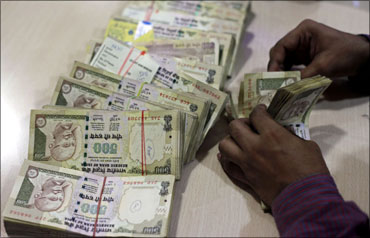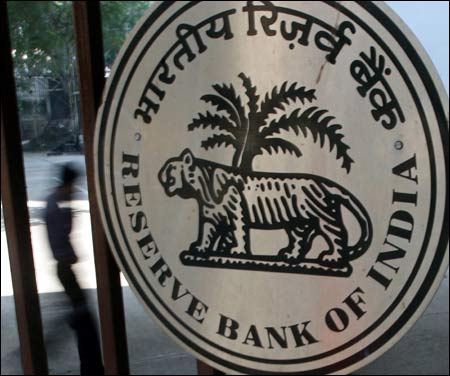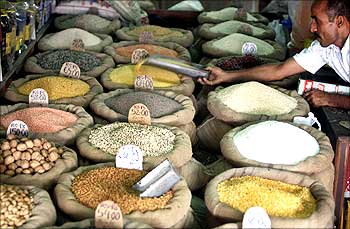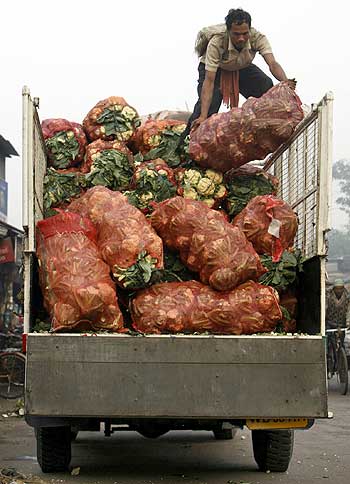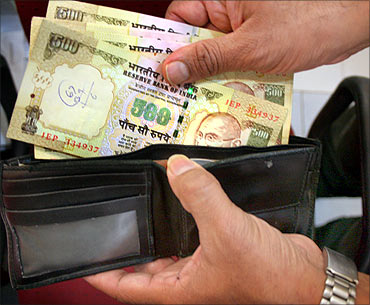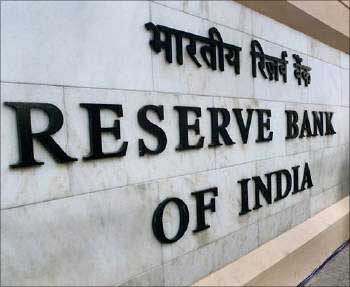 | « Back to article | Print this article |
RBI raised interest rates; how this impacts you!
The Reserve Bank of India on Thursday increased the short-term lending and borrowing rates by 25 basis points (0.25 per cent), ushering in an era of higher interest rates as inflation continues an unbridled run.
The RBI raised each repo rate under the liquidity adjustment facility by 25 basis points from 6.5 per cent to 6.75 per cent and also increased the reverse repo rate under the LAF by 25 basis points from 5.5 per cent to 5.75 per cent with immediate effect.
The bank, however, retained Cash Reserve Ratio at 6 per cent.
The nation's central bank said that its policy action in this review is expected to:
1. Continue to rein in demand-side inflationary pressures while minimising risks to growth; and
2. Manage inflationary expectations and contain the spill-over of food and commodity prices into more generalised inflation.
The Reserve Bank of India, however, projected GDP growth at 8.5 per cent with an upside bias. It also warned that inflation is a matter of concern and revised its projection for FY'11 to 7 per cent from 5.5 per cent earlier.
Why did RBI increase interest rates? Click NEXT to read on . . .
Why RBI raised rates; how this impacts you!
Inflation
The bank said that after a slight moderation in January, inflation had reversed in February 2011 accompanied by a sharp increase in non-food manufactured products inflation.
As expected, the food article prices have declined substantially since January 2011. However, the prices of protein sources such as milk and 'eggs, meat and fish' continued to remain high reflecting structural demand-supply imbalances.
A number of measures contained in the Budget for 2011-12 to improve the agricultural supply response in the medium-term will aid in redressing these imbalances.
Fuel prices remain high, reflecting the global trend, with potential for further rise. Significantly, non-food manufactured products inflation, an indicator of demand side pressure, rose sharply from 4.8 per cent in January to 6.1 per cent in February and continues to stay well above its medium-term trend.
The acceleration was spread across manufacturing activities, indicating that producers are able to pass on higher input prices to consumers.
In its third quarter review, the Reserve Bank had projected year-on-year inflation for March 2011 at 7 per cent.
However, further upside risks have stemmed from high international crude prices, their impact on freely priced petroleum products, the increase in administered coal prices and pick-up in non-food manufactured product prices.
The March 2011 inflation is now estimated to be higher, at around 8 per cent.
Click NEXT to read on . . .
Why RBI raised rates; how this impacts you!
The underlying inflationary pressures have accentuated, even as risks to growth are emerging. Rising global commodity prices, particularly oil, are a major contributor to both developments.
As domestic fuel prices are yet to adjust fully to global prices, risks to inflation remain clearly on the upside, reinforced by the persistence of demand-side pressures as reflected in non-food manufacturing inflation.
The Union Budget for 2011-12 indicates some easing of demand pressures from the fiscal side, thus creating space for private investment, but this will materialise only if commitments to contain subsidies are adhered to.
Measures to increase agricultural productivity, particularly in items facing structural supply-demand imbalances, will contribute to easing food inflation over time.
Based on the current and evolving growth and inflation scenario, the Reserve Bank is likely to persist with the current anti-inflationary stance.
Click NEXT to read on . . .
Why RBI raised rates; how this impacts you!
How will this rate hike impact you?
After a rate hike, commercial banks normally increase their lending rates: meaning, they hike interest rates for home loans, car loans, personal loans, etc.
Experts meanwhile feel that banks are unlikely to hike lending rates in the short term even though the RBI hiked interest rates more than expected. But one more round of increase in key rates by the RBI will lead to a hike in home loan, personal loan, car loan, etc rates.
However, currently this means that there will be no impact on home loan/personal loan EMIs in the short term.
What about long-term impact?
Interest rate hikes adversely affect the long-term payments of the loans as they have a direct impact on your equated monthly installments (EMI).
For example, repayments may increase by over Rs 3.5 lakh (Rs 350,000) over a 20-year period on a Rs 20 lakh (Rs 2 million) home loan, if the bankers hike interest rates by up to 1 per cent.
Click NEXT to read on . . .
Why RBI raised rates; how this impacts you!
This means that consumers may have to fork out up to Rs 1,500 more every month for a home loan of Rs 20 lakh, as bankers say that interest rates could go up by 0.5-1 per cent after RBI's hawkish policy aimed at containing inflation.
Car loan and personal loan rates too are likely to be similarly impacted in the longer term.
So this is how RBI move to hike rates could affect you in the long term; especially if inflation does not come down and the central bank is forced to increase key policy rates again.
Home, auto, personal and corporate loans are likely to become expensive if the Reserve Bank hikes rates again.
A rate hike can also have a negative impact on interest sensitive sectors like consumer durables.
Floating home loan borrowers will end up paying more on their EMIs.
The rise in auto loans will be a double whammy as car manufacturers have already hiked prices.
The interest rates on personal loans are likely to rise too, as banks will pass on the burden to the consumers.
RBI's prime concern has been to tame inflation and suck out the excess liquidity from the system so that it does not trigger inflation.
Although food inflation based on wholesale prices fell to 15.52 per cent for the week ended January 8, high prices of vegetables continues to hurt the common people.
Experts, however feel tightening of rates cannot bring down rates as food inflation is a result of an inefficient food supply system and hoarding by unscrupulous traders.
Click NEXT to read on . . .
Why RBI raised rates; how this impacts you!
What risk factors influenced RBI move?
Domestic economy: India's Central Statistical Organisation's recently released estimate of GDP growth of 8.6 per cent for 2010-11 is consistent with the Reserve Bank's projection set out in the third quarter review.
The area sown under the Rabi crop is higher than in last year which augurs well for agricultural production. Even as the index of industrial production (IIP) continues to be volatile, other indicators, such as the latest Purchasing Managers' Index (PMI), direct and indirect tax collections, merchandise exports and bank credit, suggest that the growth momentum persists.
Lead indicators of services sector activity also remain robust. However, continuing uncertainty about energy and commodity prices may vitiate the investment climate, posing a threat to the current growth trajectory.
In particular, the weak performance of capital goods in the IIP suggests that investment momentum may be slowing down.
Click NEXT to read on . . .
Why RBI raised rates; how this impacts you!
Fiscal deficit
While the budgeted level of fiscal deficit for 2011-12 gives some comfort on the demand front, a potential increase in the subsidies on petroleum products and fertilizers as a result of high crude prices could put pressure on expenditure.
It is critical, therefore, to focus on the quality of expenditure, keeping the aggregate under control without compromising on the delivery of services.
Only by doing this can the fiscal situation contribute to demand-side inflation management.
Click NEXT to read on . . .
Why RBI raised rates; how this impacts you!
Current account
The Reserve Bank had expressed concern about the widening of the current account deficit (CAD) and the nature of its financing in its third quarter review.
Going by the recent robust export performance, CAD for 2010-11 is now estimated to come lower than earlier expected, at around 2.5 per cent of GDP.
While the CAD this year has been financed comfortably, it is necessary to focus on the quality of capital inflows with greater emphasis on attracting long-term components, including foreign direct investment, so as to enhance the sustainability of the balance of payments over the medium-term.
Credit conditions
While the year-on-year non-food credit growth at 23 per cent in February remains above the indicative projection of 20 per cent, the pace of credit expansion has moderated since December 2010.
Monetary transmission is increasingly visible as banks continue to raise their lending rates.
Click NEXT to read on . . .
Why RBI raised rates; how this impacts you!
What is Bank Rate?
Bank Rate is the rate at which RBI allows finance to commercial banks. Bank Rate is a tool that RBI uses for short-term purposes. Any upward revision in Bank Rate is an indication that banks should also increase lending and deposit rates.
What is CRR?
Cash reserve Ratio (CRR) is the amount of funds that the banks have to keep with the RBI. If the RBI increases the CRR, the available amount with the banks comes down. The RBI uses the CRR to drain out excessive money from the system.
What is Reverse Repo rate?
Reverse Repo rate is the rate at which the RBI borrows money from commercial banks for a short-term. Banks are happy to lend money to the RBI since their money is in safe hands and they get good interest.
An increase in reverse repo rate can prompt banks to park more funds with the RBI to earn higher returns on idle cash. It is also a tool which can be used by the RBI to drain excess money out of the banking system.
Click NEXT to read on . . .
Why RBI raised rates; how this impacts you!
What is a Repo Rate?
The rate at which the RBI lends short-term money to commercial banks is called repo rate. It is an instrument of monetary policy. Whenever banks have any shortage of funds they can borrow from the RBI. A reduction in the repo rate helps banks get money at a cheaper rate, while an increase in repo rate means that banks will have to borrow at higher rates.
Liquidity
Net liquidity injection through LAF declined from an average of around Rs 93,000 crore (Rs 930 billion) in January to Rs 79,000 crore (Rs 790 billion) in February 2011, and further to Rs 68,000 crore (Rs 680 billion) in March (up to March 16) due mainly to increase in government spending and consequent decline in government cash balances with the Reserve Bank.
Going forward, the overall liquidity situation is expected to move close to the comfort level of the Reserve Bank (+/- 1 per cent of net demand and time liabilities of banks) although it is likely to come under some temporary pressure in the second half of March due to advance tax collections.
Click NEXT to read on . . .
Why RBI raised rates; how this impacts you!
Global picture
The global scenario presents a mixed picture, the bank said. While growth in emerging market economies (EMEs) remains strong, that in the US and the Euro area is clearly gaining momentum.
However, the sharp increase in oil prices as a result of the turmoil in the Middle East and North Africa is adding uncertainty to the pace of global recovery. Further, coming on top of already elevated food and other commodity prices, the spike in oil prices has engendered inflation concerns.
Inflationary pressures in EMEs are already high as output gaps have narrowed, while headline inflation has risen noticeably in a number of advanced economies, especially in the Euro area and the UK.
Consequently, an increasing number of EMEs have begun monetary tightening, while the debate on exit from the accommodative monetary stance has come to the fore in the advanced economies.
It is as yet too early to assess the macroeconomic consequences of the natural disaster in Japan. As normalcy is restored, expenditure on reconstruction may provide a boost to the economy.
However, substitution of thermal for nuclear energy in Japan may exert further pressure on petroleum prices.
